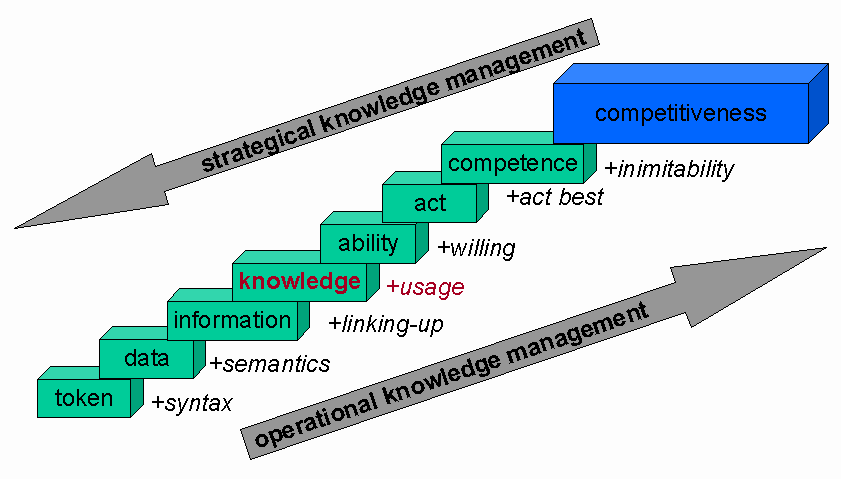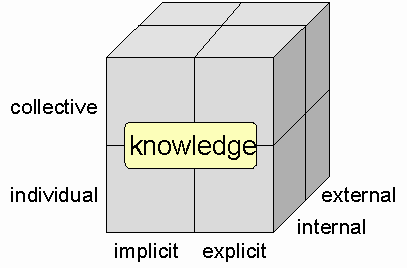- Kraak 91, p. 12: "... the result of processed information. Skills, opinions, judgements, evaluation, and goals belong to knowledge as well"
- Probst et al. 97, p. 44: "... the entirety of skills and abilities used by individuals for problem solving. Knowledge relies on data and information and is always bound to persons"
- Preissler et al. 97, p. 2: "... everything an actor is using for activities, behaviour, and solutions: skills, opinions, practical rules and techniques, pat solutions, world picture, but also customs, myths, and superstition; ... meaningfull, context-bound information"
- Chrobok 98, p. 184: "... purposive competence of the organisation and its members"
- Heinrich 95, p. 564: "... the entirety of all cognitions within a particular domain"
Knowledge relies to a certain extend on data, codified tokens without interpretation of their meaning. They are the raw material for the creation of information which reaches as a message the receiver for whom the content causes a change (world picture, self-conception) and helps him to get a new insight accepted. The usage of knowledge leads to ability of the person who acts willingly. If one acts correctly in the context one could speak of competence in this knowledge domain which leads to competitiveness in the long run. The "Knowledge Staircase" [Nort98] is a good explanation model for this facts.
Knowledge enables people using given information sources intelligently and acting accordingly.
Knowledge may be found in most structured form in databases and in documents as well as in routines, processes, practices, and standards. Knowledge is both a process and a stock. Knowledge is drawn one third out of documents and two-thirds get across by personal contacts like formal training or informal talks. [DaPr97, 98]


Product knowledge consists of knowledge of the product itself and of production knowledge. The first relates to the problem solving a product contributes to a certain extend, and the second to what technologies enable a cost effective and efficient production. Product knowledge is widely explicit and internal.
Expert knowledge comprises knowledge of relevant environments of an organisation describing how e.g. Abläufe anders als bisher gestaltet werden können. It is also explicit and may be internal or external depending on the incorporation of external advisors.
Leadership knowledge contains all standards and rules for coordination of work sharing, for authority and discipline as well as the organisational specific tools for people management. It defines the way how product and expert knowledge is treated and it is mostly of implicit mode.
Ambience knowledge combines knowledge about what expectations are drawn on whom, how controlling mechanisms work and are to be handled, which intention is expressed by what wording. It is seldom ecplicit and becomes visible through concrete experience. The demarcation to leadership resp. societal knowledge cannot be clearly met.
Societal knowledge defines what an organisation looks like, how it functions, which behavior rules obtain inside and outside the organisation, and also which legal guidelines apply for the organiastion. Ist is mostly implicit and operates as an permanent framework of all apperceptions and interpretations.
Knowledge management deals rather with product and expert knowledge and the rationing of these knowledge forms, whereas organizational learning with leadership, ambience, and societal knowledge and its critical questioning.